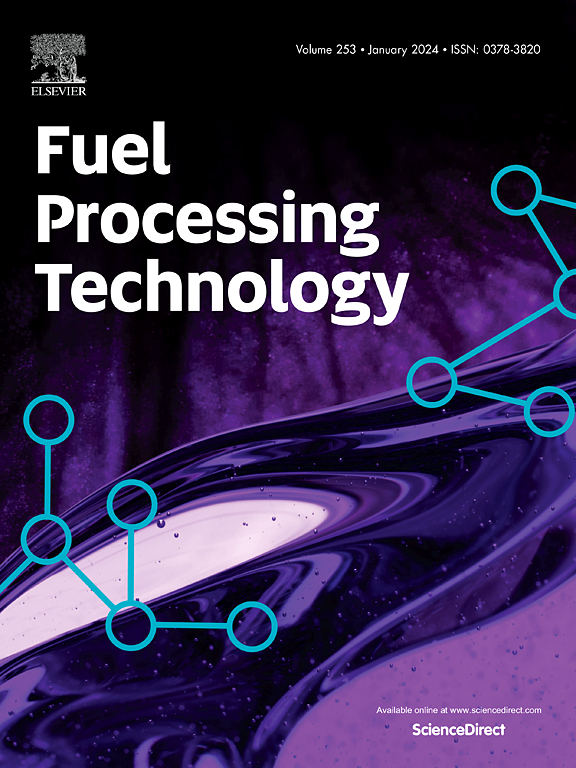焦炉煤气化学环燃烧工业造粒制备廉价铜/铁矿石复合氧载体的性能评价
IF 7.7
2区 工程技术
Q1 CHEMISTRY, APPLIED
引用次数: 0
摘要
化学环燃烧(CLC)是一种很有前途的技术,在钢铁工业中具有实现焦炉煤气(COG)有效利用和减少二氧化碳排放的双重目标的潜力。在这项工作中,两种廉价的复合氧载体CuFe20M (16 wt%的铜矿石,64 wt%的铁矿石,20 wt%的蒙脱土)和CuFe20C (16 wt%的铜矿石,64 wt%的铁矿石,20 wt%的水泥),分别通过挤压-球化和水力成型方法大规模制备。以焦炉煤气为燃料,在固定床反应器中对其燃烧性能进行了综合评价。结果表明,反应温度的选择对氧载体的性能有显著影响。在900℃时,CuFe20M和CuFe20C的CH4转化率分别达到95.90%和96.72%。CO转换对温度变化不敏感。过高的反应温度(>900°C)会导致碳沉积明显增加,导致碳捕获效率下降。提高燃气流量可以抑制碳沉积,提高碳捕集效率。相应的,反应时间的缩短会导致CO2产率的降低。COG的长周期CLC试验表明,与挤压球化CuFe20M氧载体相比,氢成型CuFe20C氧载体具有更好的稳定性和反应性。在最佳操作条件下,CuFe20C的平均CH4转化率为98.24%,CO转化率为95.35%。此外,CuFe20C具有更高的CO2产率、碳捕获效率和更低的碳沉积。本研究为廉价的复合氧载体(CuFe20C为佳)在COG的CLC中的应用提供了支持。本文章由计算机程序翻译,如有差异,请以英文原文为准。
Performance evaluation of inexpensive composite copper/iron ore oxygen carriers produced by industrial granulation in chemical looping combustion of coke oven gas
Chemical looping combustion (CLC) is a promising technology with the potential to achieve dual objectives of coke oven gas (COG) efficient utilization and reduction of CO2 emissions in the steel industry. In this work, two inexpensive composite oxygen carriers, CuFe20M (16 wt% copper ore, 64 wt% iron ore, 20 wt% montmorillonite) and CuFe20C (16 wt% copper ore, 64 wt% iron ore, 20 wt% cement), are prepared at a large scale by the extrusion-spheronization and hydroforming methods, respectively. Its combustion performance is comprehensively evaluated using coke oven gas as the fuel in a fixed-bed reactor. The results show that the selection of an appropriate reaction temperature significantly influences the performance of the oxygen carriers. The CH4 conversion of CuFe20M and CuFe20C reaches the maximum of 95.90 % and 96.72 % at 900 °C, respectively. The CO conversion is not sensitive to temperature change. Excessively high reaction temperatures (>900 °C) lead to a noticeable increase in carbon deposition, resulting in a decline in carbon capture efficiency. Increasing the fuel gas flow rate will suppress the carbon deposition and improve the carbon capture efficiency. Correspondingly, shortening the reaction time will lead to the decrease of CO2 yield. Long-period CLC tests of COG reveal that the hydroforming-derived CuFe20C oxygen carrier exhibits excellent stability and reactivity compared to the extrusion-spheronization-derived CuFe20M oxygen carrier. Under the optimal operating conditions, the average CH4 conversion and CO conversion of the CuFe20C are 98.24 % and 95.35 %, respectively. Moreover, CuFe20C exhibits higher CO2 yield, carbon capture efficiency, and lower carbon deposition. This work provides support for the application of inexpensive composite oxygen carriers (preferably, CuFe20C) in the CLC of COG.
求助全文
通过发布文献求助,成功后即可免费获取论文全文。
去求助
来源期刊

Fuel Processing Technology
工程技术-工程:化工
CiteScore
13.20
自引率
9.30%
发文量
398
审稿时长
26 days
期刊介绍:
Fuel Processing Technology (FPT) deals with the scientific and technological aspects of converting fossil and renewable resources to clean fuels, value-added chemicals, fuel-related advanced carbon materials and by-products. In addition to the traditional non-nuclear fossil fuels, biomass and wastes, papers on the integration of renewables such as solar and wind energy and energy storage into the fuel processing processes, as well as papers on the production and conversion of non-carbon-containing fuels such as hydrogen and ammonia, are also welcome. While chemical conversion is emphasized, papers on advanced physical conversion processes are also considered for publication in FPT. Papers on the fundamental aspects of fuel structure and properties will also be considered.
 求助内容:
求助内容: 应助结果提醒方式:
应助结果提醒方式:


